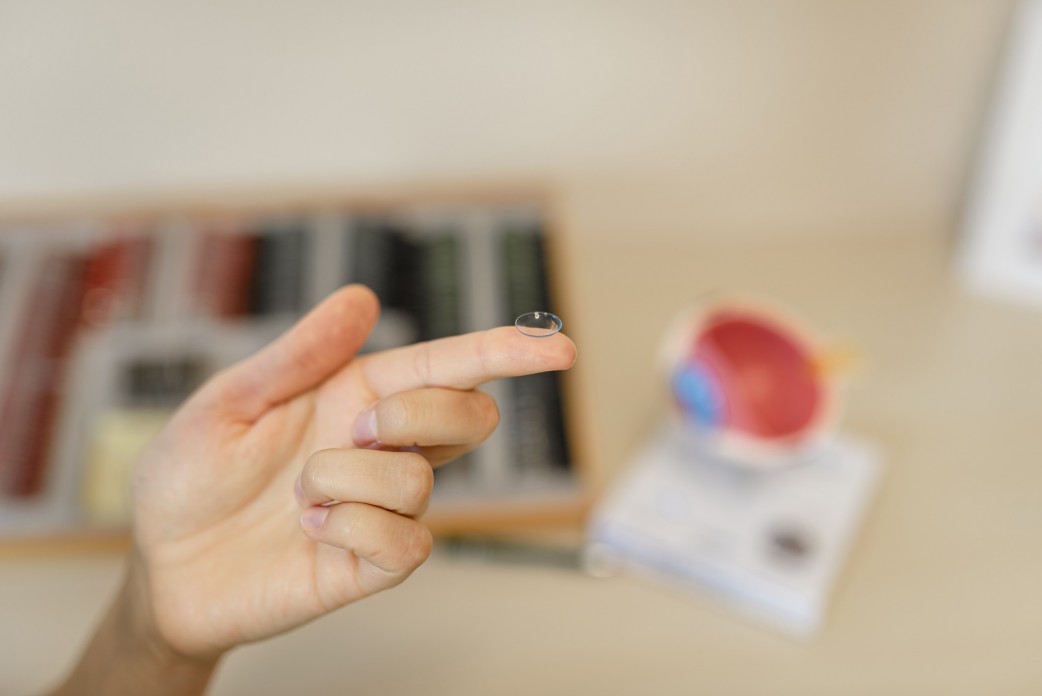To find out about the most suitable vision correction option, register for a visit, or find out other important information, leave your contacts, and we will contact you as soon as possible.
Contact lenses

Contact lenses are suitable for correction of myopia, farsightedness and astigmatism of various degrees. They can begin to be used from the child's age when they can put on and remove the contact lenses, and learn how to clean the lenses and strictly follow their wearing regimen. The exception is neonatal contact lenses used in exceptional cases and only under a pediatric ophthalmologist's supervision.
Knowing what contact lenses are right for you means understanding the differences between existing contact lens types.

There are two main types of contact lenses:
The most common type of contact lens is SOFT CONTACT LENS
Due to their comfort and short habituation, soft contact lenses are the best known and most widely used type of contact lens.
- They are ideal for occasional use.
- They gently cover the entire cornea and stay firmly on the eye throughout the day.
- Since the lens fits well to the eye's surface, they reduce the risk of various foreign objects (dust, dirt, etc.) getting under the lens.
- Soft lenses are one of the best solutions for people who engage in contact sports.
When using soft contact lenses, please do not allow them to dry out. Otherwise, the contact lenses may cause discomfort and impair the quality of vision, and drier lenses are more prone to damage. Soft contact lenses are also more susceptible to protein and lipid deposits, absorbing environmental chemicals that increase inflammation and infection risk.
Depending on the type of use, soft contact lenses are divided into one-day, two-week or monthly contact lenses.
- One-day contact lenses, or disposable contact lenses, as the name implies, are intended to be worn for one day (once a day) and then discarded. This means that there is no need to use contact lens care products, clean them after use, and buy a lens storage container. One-day contact lenses have a lower risk of eye inflammation compared to reusable contact lenses, and since they do not require maintenance, soft contact lenses also provide significant time savings, which is especially important in today's hectic pace of life;
- Two-weekly and monthly contact lenses must be properly cared for. Some contact lenses from different manufacturers are designed to be used even for several days, including at night. However, such lenses are recommended only in exceptional cases, evaluated by an ophthalmologist or optometrist in consultation with the patient. It is not recommended to wear two-week and monthly contact lenses for more than 16 hours a day.
Who and when should use hard contact lenses
For many people, hard contact lenses date back to ancient times, when they were made of hard and heavy glass, which caused significant discomfort to their users.
With the development of modern technologies in the manufacture of hard lenses, glass has been replaced by various light, air and gas porous materials, so there is no need to be afraid of hard lenses.
Hard contact lenses are often used:
- for the correction of high-grade refractive defects, such as corneal astigmatism, high-grade ametropia and keratoconus, and are used in presbyopia patients, providing a broader range of vision correction and greater visual acuity.
- Hard lenses are among the best solutions for people whose profession involves fine work, such as jewellers, watchmakers, pilots, surgeons, etc.
Although the latest generation of hard lens material provides much more comfort, it should be considered that it may take longer to get used to compared to soft contact lenses.
One type of hard contact lens is orthokeratological or night lenses, which are used only at night.
While a person is asleep, night lenses actively act on the cornea under natural pressure, slightly altering the curvature of its anterior surface and smoothing the upper layers of the epithelium, resulting in an even distribution of load successful correction of low to moderate myopia. During the day, the lenses are removed, and clear vision is provided throughout the day, even without them, giving more freedom in everyday life.
The second type of hard contact lenses is day contact lenses, which can be worn for up to 12 hours before going to bed.
Advantages of hard contact lenses:
- better oxygen access due to high gas permeability material, smaller lens diameter and more unrestrained lens movement on the eye, and more tears under the lens when blinking (by comparison, soft lenses are very immobile and tears under the lens are virtually non-existent);
- hard contact lenses also provide sharper vision, as they are made individually based on corneal topography and other examinations. The lenses retain their shape on the eye regardless of external conditions (soft lenses can change shape and degrade vision if the eye becomes drier).
- hard lenses are more durable and can be used longer - with proper care, even up to 24 months.
When choosing hard contact lenses, consider:
- more extended adaptation is needed; they should be worn every day to make them easier to get used to;
- there is a higher risk that the lens may fall out during contact sports or by rubbing the eyes. Sand and dust can get under the lens because the lens does not fit as close to the eye as it does with soft contact lenses;
- hard lenses are made individually to order, and it should be taken into account that they are slightly more expensive compared to soft lenses, so great care must be taken not to lose them
Remember!
- Vision and eye health examination by a certified ophthalmologist or optometrist is required to find the most appropriate type of contact lenses for your eyes, preferences and lifestyle!
- Under no circumstances should you try to find lenses (just like your glasses) on your own, so as not to do more harm to your vision and eye health!
- In the case of any discomfort and redness of the eyes when using contact lenses, it is advisable to seek help from an ophthalmologist or optometrist!
- From time to time, the eyes should be rested from wearing contact lenses, as the contact lenses are also foreign body. To not leave eyes without vision correction, the eyeglasses may be used during the rest, as needed.
- Strictly follow the precepts for using contact lenses!



